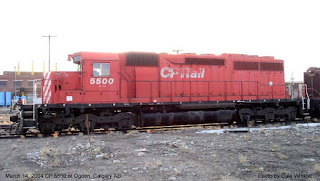While at the Manitoba Agricultural
Museum in Austin, MB this summer, I explored CPR Fowler boxcar
119462.
The 36-foot car was
built in 1914 as part of an order of 3,000 Fowler boxcars placed by the CPR
with the Canadian Car and Foundry Company.
Altogether, the CPR
owned a total of 33,000 Fowler boxcars, built between 1909 and 1915. The CNR
also owned 33,000 Fowler boxcars; Fowlers were also built for U.S.
railroads.
Fowler boxcars
carried various goods, but in Canada were best-known for carrying wheat and
other grains to market.
Some of
these cars lasted in service into the 1960s and even the early 1970s when they,
and most other grain-carrying boxcars, were replaced by the still-running “Trudeau”
cylindrical hoppers.
Designed by CPR master car builder W. E. Fowler, these wood single-sheathed steel frame boxcars had a capacity of 40 tons and a tare weight of 20 tons and 2,448 cubic feet of space. They were outfitted with archbar Simplex trucks.
Designed by CPR master car builder W. E. Fowler, these wood single-sheathed steel frame boxcars had a capacity of 40 tons and a tare weight of 20 tons and 2,448 cubic feet of space. They were outfitted with archbar Simplex trucks.
Prior to
the Fowler design, boxcars typically had wooden structural members sandwiched
between an interior and exterior wooden skin. The Fowler car eliminated the
exterior layer, producing a cheaper, lighter car that could carry a greater
payload.
This
design also prevented grain leakage at the seam between the floor and the side
of the car.
The cars were loaded through the door of the car, which was “coopered” with wood planks; a pipe was inserted through the top to fill the car.
Later, the in 1950s,
cardboard was used to replace the wood planks.
Since different crops
have different weights, lines and the names of the various grains are stenciled
on the inside of the car at the Museum—and I assume on all of the Fowler cars.
For unloading, the
planks or cardboard sheets were removed so the grain could run out. Men with shovels
scooped the remaining grain out of the cars.
The first cars built
had wooden roofs and doors, but later cars had stamped steel roofs and
corrugated steel doors. Cars were often rebuilt so early cars could appear
with steel roofs and doors or any other combinations.
The Museum’s car was
donated by the CPR in 1977.
As the Museum puts it
on its website: “Doubtlessly, 119462 is a veteran of many a fall grain ‘rush’ with countless trips to the
Lakehead, the Pacific, Montreal and into the U.S.”
The car, it adds, has “earned
its place at the Manitoba Agricultural Museum” and is “an interesting part of
the story” of agriculture in Manitoba.
With information from the Manitoba Agricultural Museum, and the Toronto Historical Railway Society. Also see OKthePK.
With information from the Manitoba Agricultural Museum, and the Toronto Historical Railway Society. Also see OKthePK.
























